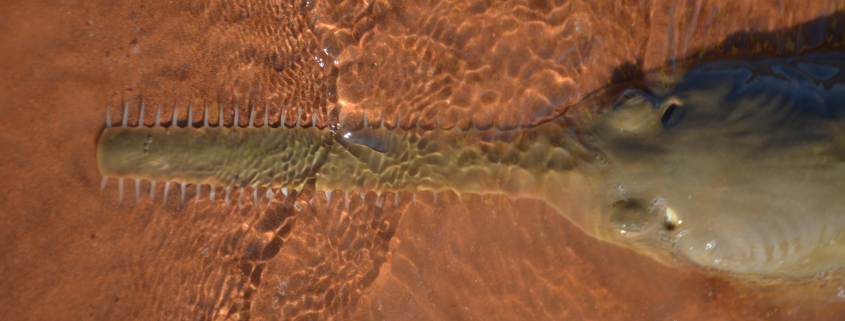Sawfish tracked as part of project to better understand the vulnerable ‘rhinos’ of Australian wildlife
The fantastically efficient inbuilt weapon sawfish use to attack prey is also their undoing, according to researcher Associate Professor David Morgan who has studied the fish for several decades.
“The saw-like rostrum on their heads is a morphological marvel,” Dr Morgan said.
“The rostrum is used to hunt, to strike food and for their own defence, but it also makes sawfish extremely vulnerable to being entangled in net.”
Sawfish are critically endangered around the world and the rostrums used to be cut off and collected as grim trophies. They became protected in Australia in 2006.
“They are the rhinoceros of Australia,” he said.
David Morgan is an associate professor at the Harry Butler Institute at Murdoch University’s Centre for Aquatic Ecosystems.
He is lead sawfish investigator on the Mardie Salt Marine Research Program, an offset project focused on the Pilbara Coast which is led by the Western Australian Marine Science Institution (WAMSI).
While coastal development and net fishing have taken their toll on the world’s five sawfish species Dr Morgan said the remoteness of Western Australia’s Pilbara coast had helped the area’s dominant species, green sawfish.
” Over 40 countries have lost at least one species of sawfish so this area is a lifeboat for three to four species globally.”
Dr Morgan said the research project had involved genetic studies from tissue sampling to establish family trees as well as tagging linked to acoustic monitors which helped establish the population and range of green sawfish.
“One thing we have found as part of this work is that the mouth of the Ashburton River is an important pupping site for sawfish, in other words where the females come to give birth.”
The study has shown that green sawfish have at least five pups in a litter.
“Our research has shown between 50 and 60 females used the Ashburton area to pup and once the young reach about three metres they move further offshore,” Dr Morgan said.
“We know they will keep returning to this site and our studies have shown the female pups once they have matured, will also return to the area.”
Acoustic and drone studies have been used to discover the distances travelled by sawfish.
“We put acoustic tags on sawfish much like the ones that are used to track white sharks and then set up receivers on moorings,” Dr Morgan said.
“We have noticed some sawfish moving relatively long distances and travelling in pairs.”
He said a new part of the study in 2025 involved looking at the movement of sawfish between Onslow and just south of Karratha.
“There is a big area where we want to find out more about how sawfish use the mangrove systems.”

